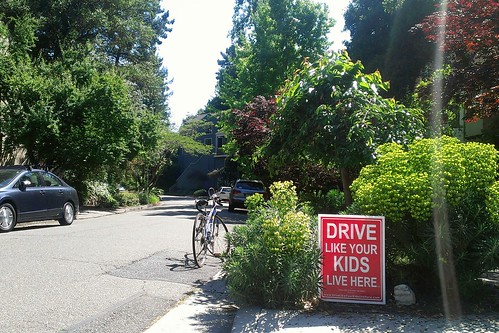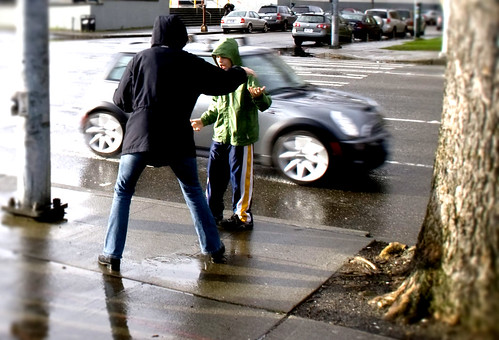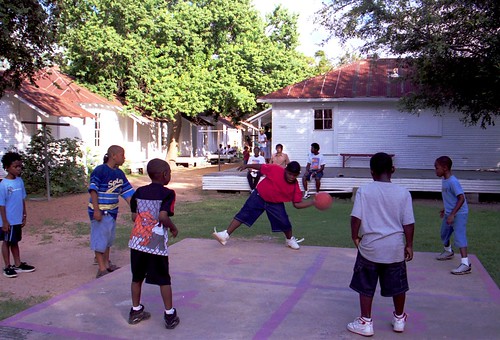No child left outside

Posted November 11, 2013 at 1:45PM
On the same day last week, I came across two stories that I believe are closely (and unfortunately) related: In the first, a new report details the mental health consequences for children of spending less time playing, particularly on their own. In the second, a mom in Texas was apparently arrested last year for the simple act of letting her kids play outside. Sounds unbelievable, no? I’ll get to both but, first, some background:
When I spoke to a conference of community developers in Cincinnati last month, I was lucky to have a packed room. I asked for a show of hands on the question, “When you were a kid, how many of you walked or rode a bike to school?” Hands went up all over the place, just about everyone 35 or older. I then asked, “How many of you have kids who walk or ride a bike to school?” About five people.
Now, the comparison wasn’t mathematically fair, since everyone in the room was eligible to answer the first question, and only those who were parents of school-age kids were eligible to answer the second. But there are data suggesting that the result was fairly representative. As recently as the 1970s, a strong majority – I believe over 60 percent – of kids walked or biked to school. I’ve read that, now, the percentage is in the low teens.
Heck, the city of Saratoga Springs in New York made national news some years ago when a middle school refused to admit a student who, on national Bike to Work day, bicycled to school with his mom. On the other side of the country, Laguna Beach’s schools declined to join the other 425 in California who participated in Walk to School Day in 2010 because walking to school, the decision-makers determined, was inherently unsafe, no matter how coordinated and supervised.
How in the world did it come to this? Well, as I’ve written before, school sprawl – placing new schools on the edges of communities where no one lives within walking distance even if that’s what they would prefer – is a significant part of the problem.
So is our automobile culture, which has led to busy, sometimes high-speed suburban roads and a distinct lack of pedestrian infrastructure. It’s unfortunate, but not exactly irrational, in many parts of the US to be fearful of your kids’ safety on some of these roads. (Be fearful for grownups, too: consider the Woodbridge, Virginia circumstances under which two men were struck by cars in separate incidents on the same day while attempting to cross a road. Neither was killed, thank goodness, but both were admitted to hospitals and then arrested for interfering with traffic.)
The result doesn’t just affect walking to school, of course. Today’s kids aren’t exercising as much in general as previous generations, contributing to the sad statistic that 32 percent are overweight. Mostly lost in the national conversation about nutrition, video games and the like is that our built environment is also a significant contributor, placing schoolmates at long distances from each other, making walking inconvenient and unsafe, and providing fewer opportunities for spontaneous outdoor play. Lee Epstein and I wrote an essay about it in 2009, shortly after a strong policy statement on the subject was published by the American Academy of Pediatrics. The Academy’s conclusion? Sprawl inhibits kids’ exercise by making walking to school difficult and discouraging walking for other activities.
But there’s more to it, isn’t there? I find the degree to which kids’ activities are supervised and planned today to be way, way greater than it was back in the day. Parents are fearful of accidents and crime, and busy working parents “hover” over their children in part because that’s the only way they get to spend time with them. Kids are allowed to do very little exploring on their own, as a result missing what Michael Chabon has called “the wilderness of childhood.”
“Childhood is, or has been, or ought to be, the great original adventure, a tale of privation, courage, constant vigilance, danger, and sometimes calamity,” Chabon wrote in The New York Review of Books, but adults have contrived to provide “a door-to-door, all-encompassing escort service . . . We schedule their encounters for them, driving them to and from one another's houses so they never get a chance to discover the unexplored lands between.”
The consequences, according to a psychologist and professor at Boston College, are that “without the freedom to play, they will never grow up.” Peter Gray’s 5,100-word essay on the subject was recently published in Aeon magazine; it is at once highly thoughtful and damning of our current nanny culture:
“Beginning around 1960 or a little before, adults began chipping away at [kids’] freedom by increasing the time that children had to spend at schoolwork and, even more significantly, by reducing children’s freedom to play on their own, even when they were out of school and not doing homework. Adult-directed sports for children began to replace ‘pickup’ games; adult-directed classes out of school began to replace hobbies; and parents’ fears led them, ever more, to forbid children from going out to play with other kids, away from home, unsupervised. There are lots of reasons for these changes but the effect, over the decades, has been a continuous and ultimately dramatic decline in children’s opportunities to play and explore in their own chosen ways.”
Gray goes on to document that, over that same period of time, mental health in children has declined sharply, as measured by standardized tests that have been essentially unchanged for 50 years. The presence of anxiety disorder and major depression are now five to eight times what they were in the 1950s, and the suicide rate for children under age 15 has quadrupled.
Gray also reports that empathy has declined and narcissism has risen, because kids no longer learn social skills from unsupervised peer activity outside the school environment:
“Empathy refers to the ability and tendency to see from another person’s point of view and experience what that person experiences. Narcissism refers to inflated self-regard, coupled with a lack of concern for others and an inability to connect emotionally with others. A decline of empathy and a rise in narcissism are exactly what we would expect to see in children who have little opportunity to play socially. Children can’t learn these social skills and values in school, because school is an authoritarian, not a democratic setting. School fosters competition, not co-operation; and children there are not free to quit when others fail to respect their needs and wishes . . .”
“If we love our children and want them to thrive, we must allow them more time and opportunity to play, not less. Yet policymakers and powerful philanthropists are continuing to push us in the opposite direction — toward more schooling, more testing, more adult direction of children, and less opportunity for free play.”
Playing, Gray emphasizes, is not a break from learning but, rather, a different and necessary kind of learning. It is where kids become socialized and learn how to negotiate, how to create, how to assess risk and overcome fear. None of these things are optimized in a classroom or other setting where superiors, not peers, are in charge. A memorable pull quote from the article notes that “Tantrums might work with parents, but they never work with playmates.”
I see two themes at work in the foregoing: First, we need an environment that allows – indeed, encourages – children to be outdoors more, to exercise and explore. And, second, we need more unstructured time for kids to be with their peers and learn life skills that they can’t learn as well any other way. These two themes come dramatically together in the case of Tammy Cooper, the mom who was arrested for allowing her kids to ride their scooters in a cul-de-sac in La Porte, Texas, a suburb of Houston.
I’m not a big fan of cul-de-sacs because they diminish street connectivity, discouraging adult walking. But they do reduce local traffic, if you discount the arterials required to get to and from them. This was not a particularly unsafe situation. And Cooper wasn’t neglecting her kids; she was on the porch watching them. But a neighbor (with an ax to grind?) complained. Cooper was arrested for “child endangerment,” handcuffed in front of her kids, and forced to spend a night in jail before charges were dropped. Watch the short TV news report below for some of the context:
Is this a great country or what?
Related posts:
- The popsicle test, the Halloween test, and neighborhoods for kids (August 22, 2011)
- Connecting neurons and neighborhoods: kids' health and urban planning (April 12, 2011)
- Kids’ perspective on safe walkability (February 18, 2010)
- Has lousy planning contributed to “the lost wilderness of childhood”? (August 6, 2009)
- The Academy of Pediatrics' statement on kids' health and the built environment, along with a guest's small-town reverie (May 29, 2009)
Move your cursor over the images for credit information. Thanks to George Osner and Karja Hansen for tipping me to these stories.



